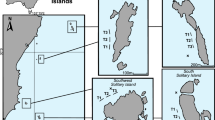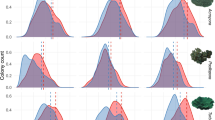Abstract
The size structure of coral populations is influenced by biotic and physical factors, as well as species-specific demographic rates (recruitment, colony growth, mortality). Coral reefs surrounding Moorea Island are characterized by strong environmental gradients at small spatial scales, and therefore, we expected that the size structure of coral populations would vary greatly at this scale. This study aimed at determining the degree of spatial heterogeneity in the population size structure of two coral taxa, Pocillopora meandrina and massive Porites spp., among depths (6, 12, and 18 m) and among locations (Vaipahu, Tiahura and Haapiti) representing different exposure to hydrodynamic forces. Our results clearly underlined the strong heterogeneity in the size structure of both P. meandrina and massive Porites spp., with marked variation among depths and among locations. However, the lack of any consistent and regular trends in the size structure along depths or among locations, and the lack of correlation between size structure and mean recruitment rates may suggest that other factors (e.g., stochastic life history processes, biotic interactions, and disturbances) further modify the structure of coral populations. We found that the size structure of P. meandrina was fundamentally different to that of massive Porites spp., reflecting the importance of life history characteristics in population dynamics.





Similar content being viewed by others
References
Adjeroud, M., 1997. Factors influencing spatial patterns on coral reefs around Moorea, French Polynesia. Marine Ecology Progress Series 159: 105–119.
Adjeroud, M., D. Augustin, R. Galzin & B. Salvat, 2002. Natural disturbances and interannual variability of coral communities on the outer slope of Tiahura (Moorea, French Polynesia): 1991–1997. Marine Ecology Progress Series 237: 121–131.
Adjeroud, M., Y. Chancerelle, M. Schrimm, T. Perez, D. Lecchini, R. Galzin & B. Salvat, 2005. Detecting the effects of natural disturbances on coral assemblages in French Polynesia: a decade survey at multiple scales. Aquatic Living Resources 18: 111–123.
Adjeroud, M., L. Penin & A. Carroll, 2007. Spatio-temporal heterogeneity in coral recruitment around Moorea, French Polynesia: implications for population maintenance. Journal of Experimental Marine Biology and Ecology 341: 204–218.
Babcock, R. C., 1991. Comparative demography of three species of scleractinian corals using age- and size-dependent classifications. Ecological Monographs 61: 225–244.
Baird, A. H. & T. P. Hughes, 1997. Spatial variation in coral recruitment around Lizard Island. Proceedings of the 8th International Coral Reef Symposium 2: 1207–1210.
Bak, R. P. M. & E. H. Meesters, 1998. Coral population structure: the hidden information of colony size-frequency distributions. Marine Ecology Progress Series 162: 301–306.
Bak, R. P. M. & E. H. Meesters, 1999. Population structure as a response of coral communities to global change. American Zoologist 39: 56–65.
Barry, J. P. & M. J. Tegner, 1990. Inferring demographic processes from size-frequency distributions: simple models indicate specific patterns of growth and mortality. Fishery Bulletin US 88: 13–19.
Bendel, R. B., S. S. Higgins, J. E. Teberg & P. A. Pyke, 1989. Comparison of skewness coefficient, coefficient of variation and Gini coefficient as inequality measures within populations. Oecologia 78: 394–400.
Bessat, F., M. Boiseau, A. Juillet-Leclerc, D. Buigues & B. Salvat 1997. Tomodensimétrie et mesures du rapport isotopique 18O/16O sur Porites lutea à Mururoa (Polynésie française): une nouvelle approche pour appréhender l’influence du rayonnement sur la croissance corallienne annuelle. Comptes Rendus de l’Académie des Sciences de Paris, Sciences de la Vie 320: 659–665.
Bianchi, C. N., C. Mori, M. Pichon, F. Benzoni, P. Colantoni, G. Baldelli & M. Sandrini, 2006. Dynamics and pattern of coral recolonization following the 1998 bleaching event in the reefs of the Maldives. Proceedings of the 10 th International Coral Reef Symposium, 30–37.
Connell, J. H., T. P. Hughes & C. C. Wallace, 1997. A 30-year study of coral abundance, recruitment, and disturbance at several scales in space and time. Ecological Monographs 67: 461–488.
Done, T. J., 1988. Simulation of recovery of pre-disturbance size structure in populations of Porites species damaged by the crown of thorns starfish Acanthaster planci. Marine Biology 100: 51–61.
Ebert, T. A., 1981. Estimating mortality from growth parameters and a size distribution when recruitment is periodic. Limnology and Oceanography 26: 764–769.
Endean, R. & A. M. Cameron, 1990. Acanthaster planci population outbreaks. In Dubinsky, Z. (ed.), Coral Reefs. Elsevier, Amsterdam, 419–437.
Fong, P. & P. W. Glynn, 1998. A dynamic size-structured population model: does disturbance control size structure of a population of the massive coral Gardineroseris planulata in the Eastern Pacific? Marine Biology 130: 663–674.
Fong, P. & P. W. Glynn, 2001. Population abundance and size-structure of an eastern tropical Pacific reef coral after the 1997–98 ENSO: a simulation model predicts field measures. Bulletin of Marine Science 69: 187–202.
Gilmour, J. P., 2004. Size-structures of populations of the mushroom coral Fungia fungites: the role of disturbance. Coral Reefs 23: 493–504.
Gleason, M. G., 1996. Coral recruitment in Moorea, French Polynesia: the importance of patch type and temporal variation. Journal of Experimental Marine Biology and Ecology 207: 79–101.
Grigg, R. W. & J. E. Maragos, 1974. Recolonization of hermatypic corals on submerged lava flows in Hawaii. Ecology 55: 387–395.
Hughes, T. P., 1984. Population dynamics based on individual size rather than age: a general model with a reef coral example. American Naturalist 123: 778–795.
Hughes, T. P. & J. B. C. Jackson, 1980. Do corals lie about their age? Some demographic consequences of partial mortality, fission and fusion. Science 209: 713–714.
Hughes, T. P. & J. B. C. Jackson, 1985. Population dynamics and life histories of foliaceous corals. Ecological Monographs 55: 141–166.
Hughes, T. P., A. H. Baird, E. A. Dinsdale, N. A. Moltschaniwskyj, M. S. Pratchett, J. E. Tanner & B. L. Willis, 1999. Patterns of recruitment and abundance of corals along the Great Barrier Reef. Nature 397: 59–63.
Laboute, P., 1985. Evaluation des dégats causés par les passages des cyclones de 1982–1983 en Polynésie française sur les pentes externes des atolls de Tikehau et de Takapoto (Archipel des Tuamotu). Proceedings of the 5th International Coral Reef Congress 3: 323–329.
Laurent, V., K. Maamaatuaiahutapu, J. Maiau & P. Varney, 2004. Atlas climatologique de la Polynésie française. MétéoFrance, Papeete.
Lewis, J. B., 1989. Spherical growth in the coral Siderastrea radians (Pallas) and its survival in disturbed habitats. Coral Reefs 7: 161–167.
Lewis, J. B., 1997. Abundance, distribution and partial mortality of the massive coral Siderastrea siderea on degrading coral reefs at Barbados, West Indies. Marine Pollution Bulletin 34: 622–627.
Magalon, H., M. Adjeroud & M. Veuille, 2005. Patterns of genetic variation do not correlate with geographical distance in the reef-building coral Pocillopora meandrina in the South Pacific. Molecular Ecology 14: 1861–1868.
Meesters, E. H., M. Hilterman, E. Kardinaal, M. Keetman, M. de Vries & R. P. M. Bak, 2001. Colony size-frequency distributions of scleractinian coral populations: spatial and interspecific variation. Marine Ecology Progress Series 209: 43–54.
Nakamura, T. & T. Nakamori, 2006. Population dynamics of hermatypic coral communities on reef slope vs. reef flat at Shiraho, Ishigaki Island, southwest Japan. Proceedings of the 10th International Coral Reef Symposium, 460–477.
Penin, L., M. Adjeroud, M. Schrimm & H. S. Lenihan, 2007. High spatial variability in coral bleaching around Moorea (French Polynesia): patterns across locations and water depths. Comptes Rendus de Biologies 330: 171–181.
Potts, D. C., T. J. Done, P. J. Isdale & D. A. Fisk, 1985. Dominance of a coral community by the genus Porites (Scleractinia). Marine Ecology Progress Series 23: 79–84.
Sebens, K. P., 1983. Structure and growth rates in populations of colonial and solitary invertebrates. In Reaka, M. L. (ed.), The Ecology of Deep and Shallow Coral Reefs, Vol. 1(1). NOAA Undersea Research Program, 9–15.
Soong, K., 1993. Colony size as a species character in massive reef corals. Coral Reefs 12: 77–83.
Tomascik, T., R. van Woesik & A. J. Mah, 1996. Rapid coral colonization of a recent lava flow following a volcanic eruption, Banda Islands, Indonesia. Coral Reefs 15: 169–175.
Vermeij, M. J. A. & R. P. M. Bak, 2002. Inferring demographic processes from population size structure in corals. Proceedings of the 9th International Coral Reef Symposium 1: 598–593.
Wittenberg, M. & W. Hunte, 1992. Effects of eutrophisation and sedimentation on juvenile corals. I. Abundance, mortality and community structure. Marine Biology 112: 131–138.
Acknowledgements
This manuscript was greatly improved following discussions with DC Afzal, AH Baird, RPM Bak and TP Hughes, and critical comments made by anonymous reviewers. This research was supported by grants from the Plan Pluri Formation EPHE, from “La Fondation d’Entreprise Total”, from the Ministère de l’Outre-Mer, and from the Research Programmes BioAqua (Délégation à la Recherche de la Polynésie française, DRRT, ANR) and CoralDiv (ANR).
Author information
Authors and Affiliations
Corresponding author
Additional information
Handling editor: I. Nagelkerken
Rights and permissions
About this article
Cite this article
Adjeroud, M., Pratchett, M.S., Kospartov, M.C. et al. Small-scale variability in the size structure of scleractinian corals around Moorea, French Polynesia: patterns across depths and locations. Hydrobiologia 589, 117–126 (2007). https://doi.org/10.1007/s10750-007-0726-2
Received:
Revised:
Accepted:
Published:
Issue Date:
DOI: https://doi.org/10.1007/s10750-007-0726-2




